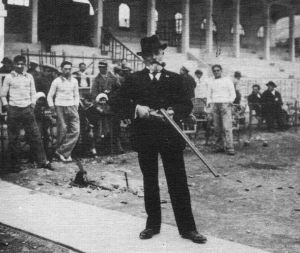Entrepreneur
 Orazio Parea was born in Porto S. Maurizio (today Imperia) on 27 July 1869 from Luigi and Jenny Roverizio of Roccasterone, the second of five children.
Orazio Parea was born in Porto S. Maurizio (today Imperia) on 27 July 1869 from Luigi and Jenny Roverizio of Roccasterone, the second of five children.
Eclectic personality, long time captain, in life he was an entrepreneur.
The Echo of the Riviera, giving ample news of his death, reminded him as follows: "Count Orazio Parea, one of the most famous figures, one of the most active, brilliant, enterprising, reflecting the vitality of our late nineteenth century chivalric and daring, full of always renewed energy. "
Distinguished, diligent, generous, jovial, Sanremasco 'scetu' held many positions and in all of them left the mark of his talents.
He was president of the action committee among the mutilated and invalids of war, president of the anti-German League, president of the Sanremo Workers' Federation, president of the board of directors of the Sanremo and coastal road companies, president of the Sanremo hunters' society, president of the Matuzia club of the municipal casino, president of the Sanremo section of the naval league, president of the autonomous body for the administration of the climatic station, founding member and member of the board of directors of the Sanremo automobile club.
He took an interest in all the city's problems by designing and proposing various works: for example, a gallery to divert the San Francesco torrent into the San Romolo torrent: the main aims of the operation were 1) to preserve the port from being buried 2) to reclaim and make about 40,000 square metres of land suitable for building 3) to free the Marina district and the neighbouring Arenella from the pestilential and absorbing miasms to which they were subjected during the summer months.
A funicular between the Maria Vittoria public garden and Piazza San Bernardo destined to overcome a difference in height of 33 metres.
The transformation of Via Privata, now Via Escoffier, into a monumental gallery covered by a glass window.
And last but not least, the moving of the railway upstream of the city.
In 1906 Count Parea left for Argentina and there near Rufino, in the Pampas he bought a vast estate where he took up residence.
Returning to Sanremo, immediately after the war he dealt with the problems of the city and as president of the workers' federation he distributed subsidies to the needy families of the members called to arms, thus affecting his personal patrimony.
He worked with the Council of Ministers to obtain the approval of a law regulating the opening of casinos in favour of the Municipal Casino of Sanremo.
In 1924 he took over the ownership and management of the bathing establishment in Corso Trento Trieste, making the whole building modern by adding a terrace overlooking the sea and new rooms which were frescoed by Antonio Rubino who was inspired by the plot of the Fata Morgana for the decoration. Even on the beach everything was innovated and two floors were built in reinforced concrete and two long rows of cabins. The establishment was inaugurated on 17th July 1924 and was named Morgana: a poster, also designed by Rubino, made our beach known all over Italy.
During his presidency of the autonomous body for the administration of the Sanremo tourist resort, the golf course in the Gogna region was inaugurated. Count Parea was also a gallant man. Very gallant. He owned a "cotre", a motor sailboat with the name Matuzia, which moored at the western pier or in the middle of the harbour and can still be seen in some period postcards.
On 19th November 1944 he died in Sanremo.
(source : Marco Mauro)




